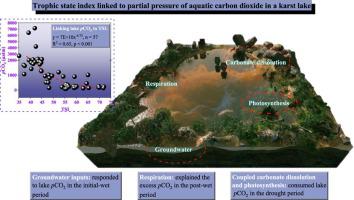Ecological Indicators ( IF 6.9 ) Pub Date : 2020-09-09 , DOI: 10.1016/j.ecolind.2020.106912 Maofei Ni , Qiushi Ge , Siyue Li , Zhikang Wang , Yunjie Wu

|
Trophic state index (TSI) can assess lake trophic status and trace in-situ metabolism, exhibiting a high potential in explaining autochthonous carbon dioxide (CO2) in aquatic environments. However, there remains a knowledge gap in how TSI links to the partial pressure of CO2 (pCO2) generated and consumed in lakes. Here we explored the temporal variations of lake pCO2 and TSI, as well as their linkages in a karst plateau lake. Lake pCO2 ranged from 90.1 to 7169.3 μatm and was significantly high in the post-wet period (2534.3 ± 1637.9 μatm). Over 58% of samples were found to be supersaturated in CO2 with respect to the atmospheric equilibrium (410 μatm). Biological and hydrological processes regulated lake trophic status, resulting in mesotrophic state (30 < TSI < 50) in the post-wet period and eutrophic state (TSI > 50) in the drought and initial-wet periods. Coupled carbonate dissolution and photosynthesis consumed the pCO2, whereas groundwater and respiration contributed the pCO2 in the karst lake. Our results highlighted that lake TSI could decipher trophic status and further partially explain the pCO2 dynamics and sources.
中文翻译:

在典型的喀斯特高原湖泊中,营养状态指数与水生二氧化碳分压相关
营养状态指数(TSI)可以评估湖泊的营养状态并追踪原位代谢,在解释水生环境中的原生碳(CO 2)方面具有很高的潜力。但是,在TSI与湖泊中产生和消耗的CO 2(p CO 2)分压之间的联系方面,仍然存在知识差距。在这里,我们探讨了喀斯特高原湖泊中p CO 2和TSI湖泊的时空变化以及它们之间的联系。Lake p CO 2的范围从90.1到7169.3μatm,并且在湿后时期显着较高(2534.3±1637.9μatm)。发现超过58%的样品在CO中过饱和2相对于大气平衡(410μatm)。生物和水文过程调节了湖泊的营养状态,在干旱后的湿润时期导致了中营养状态(30 <TSI <50),而在干旱和湿润的初期则形成了营养状态(TSI> 50)。碳酸盐溶解和光合作用相结合消耗了p CO 2,而地下水和呼吸作用在喀斯特湖中贡献了p CO 2。我们的结果表明,TSI湖可以解释营养状态,并进一步部分解释p CO 2的动力学和来源。



























 京公网安备 11010802027423号
京公网安备 11010802027423号